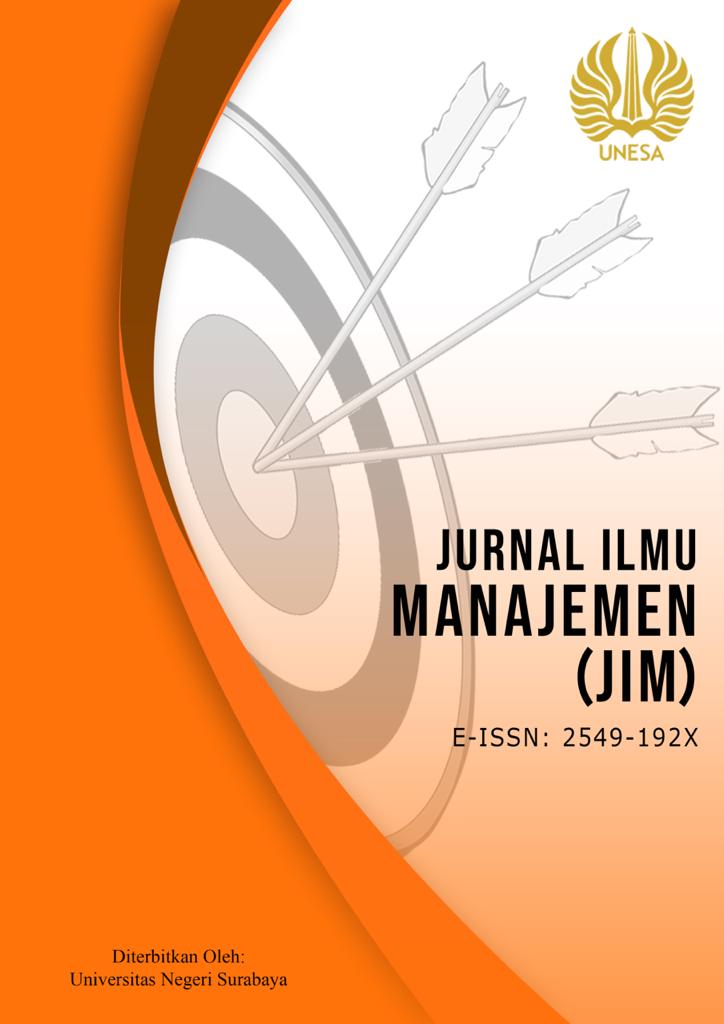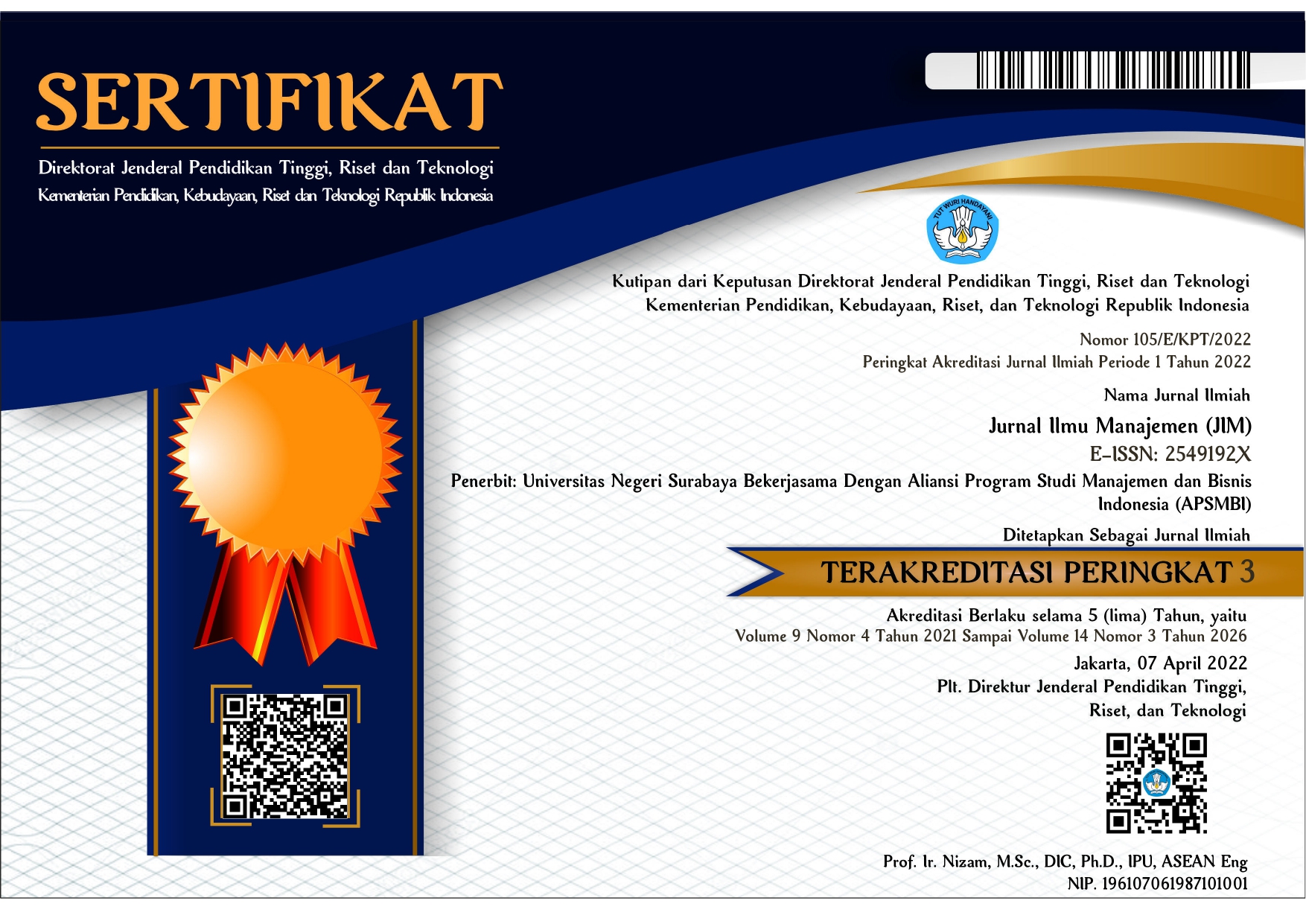Middle managerial capability, teamwork dan performance: studi peran leader gender
DOI:
https://doi.org/10.26740/jim.v12n2.p481-495Keywords:
indonesian police, leader gender, middle manager capability, teamworkAbstract
The background to this research is based on the fact that the Republic of Indonesia Police organisation views the existence of women and children as important. This is demonstrated by forming the Directorate of Women and Children Services (PPA). Empirically, women's leadership in all processes positively impacts organisational performance. For this reason, what is of concern in this research is women's leadership as an answer to the complexity of the East Java Regional Police's PPA work. This research aims to urgently carry it out considering the high number of PPA cases in the East Java Regional Police to test the role of middle managers' capabilities in shaping performance through teamwork with gender leadership mechanisms. The methodology used is quantitative research with a survey approach using census techniques. The results of testing the interaction of leader gender as a moderator variable are shown by an interaction coefficient value of -0.189, with a p-value of 0.003 <0.05. Thus it can be said that leader gender influences the magnitude of the influence of middle managers' managerial ability (MMC) on teamwork (TMW). The implementation of the research results can be conveyed that the smaller the leader's gender (female leader), the stronger the influence of middle manager capabilities on teamwork.
References
Adams, R. B., & Ferreira, D. (2009). Women in the boardroom and their impact on governance and performance. Journal of Financial Economics, 94(2), 291-309. https://doi.org/https://doi.org/10.1016/j.jfineco.2008.10.007
Adeosun, O. T., Shittu, A. I., & Aju, S. I. (2021). Innovation capabilities of women enterprise in informal settings. Journal of Enterprising Communities: People and Places in the Global Economy, 15(1), 96-113. https://doi.org/10.1108/JEC-04-2020-0063
Adams, R. B., & Ferreira, D. (2009). Women in the boardroom and their impact on governance and performance. Journal of Financial Economics, 94(2), 291-309. doi:https://doi.org/10.1016/j.jfineco.2008.10.007
Adunni, A.-B. T., & Omolara, O. K. (2023). Influence for Capacity Building on Job Commitment of Personnel in Academic Libraries in Ogun State, Nigeria. The International Journal of Humanities & Social Studies. 11(1), 1-9 doi:10.24940/theijhss/2023/v11/i1/HS2212-007
Alford, P., & Duan, Y. (2018). Understanding collaborative innovation from a dynamic capabilities perspective. International Journal of Contemporary Hospitality Management, 30(6), 2396-2416. doi:10.1108/IJCHM-08-2016-0426
Azevedo, A., & Shane, M. J. (2019). A new training program in developing cultural intelligence can also improve innovative work behavior and resilience: A longitudinal pilot study of graduate students and professional employees. The International Journal of Management Education, 17(3). doi:10.1016/j.ijme.2019.05.004
Barry, T. T., Longacre, M., Carney, K. O., & Patterson, S. (2019). Team inclusion and empowerment among nursing staff in long-term care. Geriatr Nurs. doi:10.1016/j.gerinurse.2019.03.014
Elliott, G., Day, M., & Lichtenstein, S. (2019). Strategic planning activity, middle manager divergent thinking, external stakeholder salience, and organizational performance: a study of English and Welsh police forces. Public Management Review, 22(11), 1581-1602. doi:10.1080/14719037.2019.1635194
Giauque, D. (2014). Attitudes Toward Organizational Change Among Public Middle managers. Public Personnel Management, 44(1), 70-98. doi:10.1177/0091026014556512
Gonzalez, R. V. D., & Melo, T. M. (2019). Analyzing dynamic capability in teamwork. Journal of Knowledge Management, 23(6), 1196-1217. doi:10.1108/jkm-08-2018-0478
Hair, J. F., Black, W. C., Babin, B. J., & Anderson, R. E. (2010). Multivariate Data Analysis 7th_Edition: Pearson Prentice Hall.
Hanaysha, J. (2016). Examining the Effects of Employee Empowerment, Teamwork, and Employee Training on Organizational Commitment. Procedia - Social and Behavioral Sciences, 2(29), 298-306. doi:10.1016/j.sbspro.2016.07.140
Isidro, H., & Sobral, M. (2014). The Effects of Women on Corporate Boards on Firm Value, Financial Performance, and Ethical and Social Compliance. Journal of Business Ethics, 132(1), 1-19. doi:10.1007/s10551-014-2302-9
Jeong, S.-H., & Harrison, D. (2016). Glass Breaking, Strategy Making, and Value Creating: MetaAnalytic Outcomes of Females as CEOs and TMT members. Academy of Management Journal, 60(4), 1219-1252.
Jiao, H., Yang, J., Zhou, J., & Li, J. (2019). Commercial partnerships and collaborative innovation in China: the moderating effect of technological uncertainty and dynamic capabilities. Journal of Knowledge Management, 23(7), 1429-1454. doi:10.1108/jkm-10-2017-0499
Joo, M. K., Lee, J. Y., Kong, D. T., & Jolly, P. M. (2022). Gender diversity advantage at middle management: Implications for high performance work system improvement and organizational performance. Human Resource Management, 62(5), 765-785. doi:10.1002/hrm.22159
Klein, H. J., & Potosky, D. (2019). Making a conceptual contribution at Human Resource Management Review. Human Resource Management Review, 29(3), 299-304. doi:10.1016/j.hrmr.2019.04.003
article/will-gender-diversity-boards-really-boost-company-performance/.
Klettner, A., Clarke, T., & Boersma, M. (2014). Strategic and Regulatory Approaches to Increasing Women in Leadership: Multilevel Targets and Mandatory Quotas as Levers for Cultural Change. Journal of Business Ethics, 133(3), 395-419. doi:10.1007/s10551-014-2069-z
Lambe, C. J., Webb, K. L., & Ishida, C. (2009). Self-managing selling teams and team performance: The complementary roles of empowerment and control. Industrial Marketing Management, 38(1), 5-16. doi:http://dx.doi.org/10.1016/j.indmarman.2007.10.003
Liu, H. (2016). An Empirical Investigation of the Relationship between the Competency and Social Capital of Village Cadres and Rural Development in Western China. Revista de cercetare si interven]ie social, 5(2), 145-172.
Mait, R. (2014). The impact of capabilities on performance. Industrial Management & Data Systems, 114(2), 241-257. doi:10.1108/IMDS-04-2013-0202
Mittal, V., Binkadakatti, J., & Sathyanarayana, K. (2023). Role of capacity building, extension and services in tasar sector. Journal of Environmental Biology, 44(3), 524-532. doi:10.22438/jeb/44/3(SI)/JEB-15
Nadilla, P. A. (2020). The effect of knowledge sharing toward employee performance with teamwork as the moderator at PT Telkom Indonesia division of regional II Jabodetabek. Jurnal Manajemen Maranatha, 20(1), 1-12. doi:10.28932/jmm.v20i1.2515
Post, C., & Byron, K. (2015). Women on boards and firm financial performance: A meta-analysis. Academy of Management Journal, 58(5), 1546-1571. doi:10.5465/amj.2013.0319
Robbins, S. P., & Judge, T. A. (2005). Organizational Behavior (15 ed.): Prentice Hall.
Salehzadeh, R., Khazaei Pool, J., Kia Lashaki, J., Dolati, H., & Balouei Jamkhaneh, H. (2015). Studying the effect of spiritual leadership on organizational performance: an empirical study in hotel industry. International Journal of Culture, Tourism and Hospitality Research, 9(3), 346-359. doi:10.1108/IJCTHR-03-2015-0012
Sekkat, K., Szafarz, A., & Tojerow, I. (2015). Sekat, Women at the Top in Developing Countries, Evidencefrom Firm-Level Data. The Institute for the Study of Labor (IZA), 9537, 1-42.
Shaik, R., Nambudiri, R., & Yadav, M. K. (2022). Mindfully performed organisational routines: reconciling the stability and change duality view. International Journal of Organizational Analysis, 30(4), 1019-1038. doi:10.1108/IJOA-12-2020-2535
Sri Lestari, T., Wekadigunawan, C., & Ruswanti, E. (2020). The Influence of Competence, Service Performance Through A Service Quality Over Midwife units in Banten Hospital. Journal of Multidisciplinary Academic, 4(4), 229-233.
Suhaeniti, & Ryu, S. (2013). Gender, middle manager management, and performance evidence from indonesian Public Schools. Economics & Management Series.
Sukoco, B. M., Lestari, Y. D., Susanto, E., Nasution, R. A., & Usman, I. (2022). Middle manager capabilities and organisational performance: the mediating effect of organisational capacity for change. International Journal of Productivity and Performance Management, 71(4), 1365-1384. doi:10.1108/IJPPM-07-2019-0364
Wei-Shong, L., Jing-Wen, H., & Ming-Yih, Y. (2015). Developing the capability of marketing intelligence: A subjective dynamic capability study. Benchmarking: An International Journal, 22(7), 1341-1359. doi:10.1108/BIJ-12-2013-0117
Wongleedee, K. (2020). The Effects of GHRM and GSCM on the Sustainable Performance of the Thailand Pharmacies: Mediating Role of Employee Performance. Systematic Review Pharmacy, 11(1), 371-379. doi:10.5530/srp.2020.1.48
Downloads
Published
How to Cite
Issue
Section
License

This work is licensed under a Creative Commons Attribution-NonCommercial 4.0 International License.
 Abstract views: 276
,
Abstract views: 276
, PDF Downloads: 163
PDF Downloads: 163











